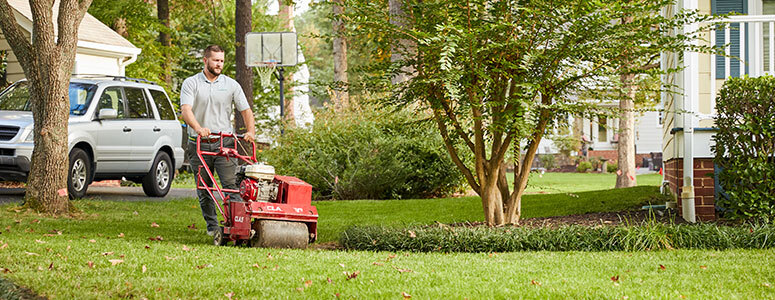Fall
Despite common belief, fall is an important time of year for lawn care. After experiencing the hot temperatures and droughts of summer, it is important to restore lawns before winter arrives.
Taking Care of Your Lawn in the Fall
It can be a little overwhelming to care for your lawn in the fall, especially without professional assistance. At Virginia Green, we can provide you with expert service in a number of ways to help you care for your lawn this fall:
- We will double aerate your property’s soil, going north-to-south over your lawn as well as east-to-west.
- Once we have double aerated your lawn’s soil, we will put down six pounds of our proprietary-blended seed per thousand square feet of your lawn.
- We will give you an extra five-pound bag of grass seed that you may use to restore any bare areas of your lawn.
- We will provide you with thorough lawn care instructions, including detailed watering and maintenance instructions, to ensure the growth of a beautiful lawn.

Need Help With Seasonal Lawn Care?
Learn more about our lawn care services that will help you get ready for any season.
Fall Tips
Keep Leaves off the Lawn
In the fall, the leaves on your trees will start changing colors and will eventually start falling to the ground. While piles of colorful leaves scattered across your lawn might provide for a beautiful view, it’s not good for your grass. You should rake your grass regularly during the fall and remove all of the dead leaves.
Leaving the leaves on your turf will prevent sunlight from reaching your grass while also trapping moisture underneath. Excessive moisture can lead to the growth of weeds, the development of rot, and other diseases.
Mow Your Lawn Regularly
Dropping temperatures does not mean the grass will stop growing. The grass will continue to grow until the first hard frost of winter. If you let your grass grow too long, it will end up matting and will become vulnerable to fungi.
Keep your grass between 3.5 to 4 inches tall. Any shorter and you could curtail the lawn’s root system, thereby stunting your grass’s ability to withstand the cold and dry weather of winter. By mowing your lawn regularly, you also chop up the dead leaves. This is an effective alternative to having to rake them; when chopped up, the leaves will work like mulch and will no longer block sunlight or trap moisture.
Water Your Grass Regularly
Even though there’s less heat from the sun to evaporate water, it is still important to water your grass regularly throughout the fall. You’ll want your grass roots to be properly hydrated and healthy enough to make it through the upcoming winter season.
Your lawn should get at least an inch of water every week. If you have a sprinkler system, you should run it through the end of October. Once November comes around, you’ll want to avoid using your sprinklers to prevent frozen pipes and spigots.
Aerate Your Soil
At the beginning of the fall, you’ll want to aerate your soil. Aeration prevents the soil from becoming compacted and being covered with thatch (a layer of roots, stems, and debris that will block oxygen, water, and nutrients from reaching your soil). Before you aerate the soil, use a rake to remove the thatch that has accumulated on the lawn.
Aerating your turf involves punching small holes into the soil. Aeration is important because it aids with proper fertilization, which will ensure your soil will have the nutrients it needs to keep the grass healthy.
There are several ways you can aerate your soil. You can either use a border fork, a hollow tine aerator, or a core aerator.
Spread Seeds
After you aerate and fertilize your lawn, you should spread grass seed to help promote the growth of more grass. This will allow you to not only fill in any bare patches in your lawn, but also to encourage the growth of a denser turf, which will prevent the growth of weeds.
Apply Top Dressing (Topsoil) to the Soil
Once the soil has been properly aerated, you may need to add topsoil to thin areas. It helps to smooth the surface of your lawn and to reduce the buildup of thatch by encouraging decomposition. You’ll want to make sure that the topsoil gets into the aerated holes to help encourage strong rooting.
Add Fertilizer to Your Lawn
Adding fertilizer will help keep your grass roots strong so they survive the winter. Towards the end of the fall, you’ll want to add a slow-release fertilizer.
Fertilizers contain a number of nutrients, but one that is particularly important for your grass root’s survival is potassium. Potassium helps to promote root growth, protect against disease, build resistance against the cold, and build tolerance against drought.
